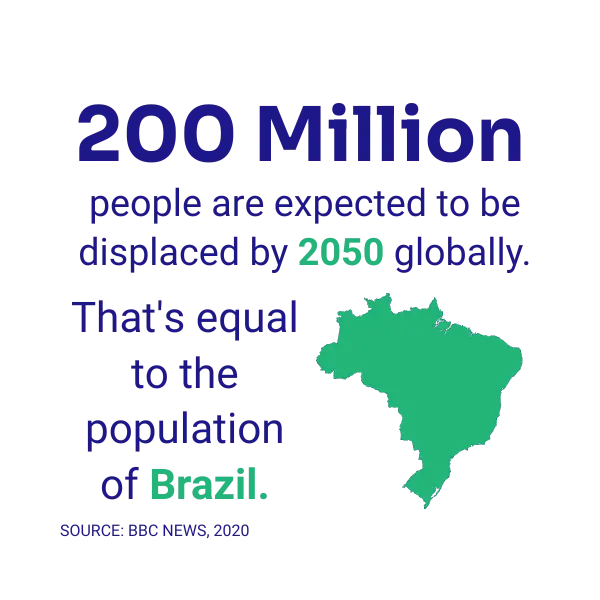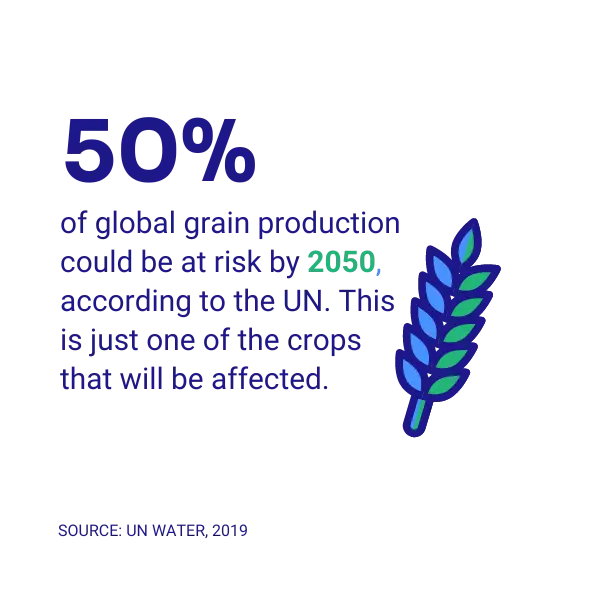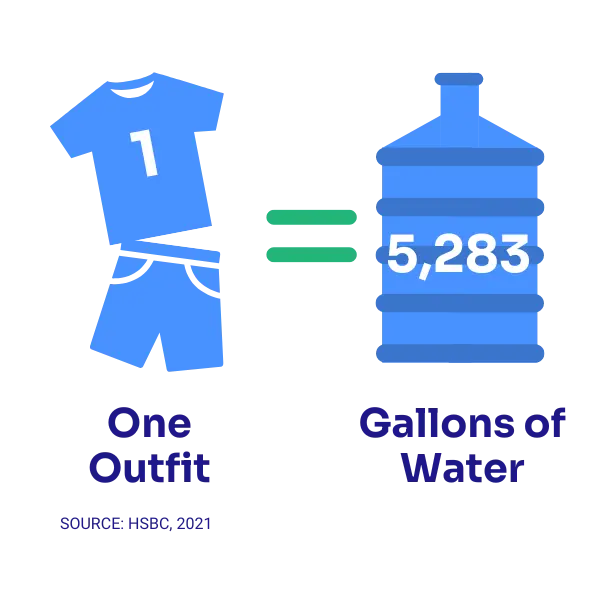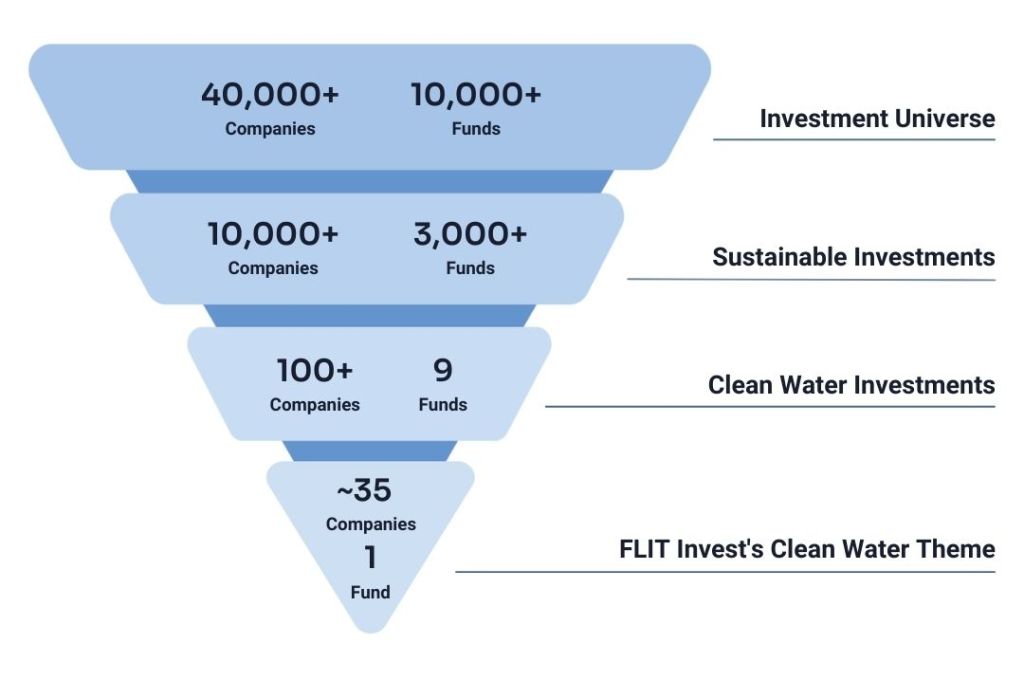An Introduction to the Global Water Crisis
The global water crisis is one of the most ubiquitous problems currently impacting our planet. 4 billion people are already affected by the water crisis, and unfortunately, those numbers are expected to rise. In 2020, at least 25% of the global population lacked access to safely managed drinking water, and almost 50% did not have access to safely managed sanitation services, according to the WHO. Despite covering most of Earth’s surface, only 0.007% of water is accessible and suitable for human consumption. As populations increase and fresh water becomes scarcer, it will inevitably become a highly sought-after resource. In fact, NASA has deemed the global water crisis the “environmental challenge of this century.”

Generally speaking, the water crisis is caused by increased demand, climate change, and pollution. All these factors culminate into a series of problems that only exacerbate the crisis itself or lead to increased human suffering. While direct pollution of drinking water is a huge problem, it is not the only cause of water scarcity. Climate change will increase the occurrence of disasters such as wildfires or floods, which can damage infrastructure and increase water scarcity, while other more abstract problems like temperature changes and urbanization can lead to an imbalance in the water cycle itself. Wetlands provide essential ecosystem services to populations, providing natural water quality improvement, flood protection, and shoreline erosion control. Over 80% of the world’s wetlands have already been lost since pre-industrial times as land is now used for housing, industry and agriculture, and this percentage is projected to increase. Other natural ecosystems such as barrier reefs and kelp forests also mitigate natural disasters such as hurricanes and tropical storms. However, these ecosystems are also under threat. For instance, the BBC reported that the great barrier reef of the coast of Australia has lost half of its corals since 1995 due to climate change leading to warmer seas. In disrupting our environment through climate change, we have not only increased the propensity for natural disasters to occur, but we have also weakened our natural defense against them in the form of wetlands, reefs, and kelp forests.
As ocean levels rise and violent weather patterns such as hurricanes increase, the destruction of these wetlands will inevitably lead to increased natural disasters such as flooding and mudslides. In fact, more than 200 million people are expected to be displaced by 2050. We are already beginning to see displacement occur with crises like the 2020 bushfires in Australia displacing 65,000 individuals or even the wildfires on the west coast of the United States, resulting in over half a million people evacuating their homes. Even if occupants are not forced to leave their homes, any kind of damage to water infrastructure will only serve to exacerbate existing supply problems in the face of ever-increasing demand and scarcity.

The UN expects global water demand to increase 20-30% by 2050, and we are already struggling to meet demand as it is. This is a global problem, but it is important to note that issues of displacement and scarcity will have a disproportionately adverse effect on the global south and undoubtedly widen inequality. NASA has identified major water shortage hotspots, including northern and eastern India, the Middle East, California, and West Africa.
Humans are also not the only species that will be negatively impacted by climate change and natural disasters. Biodiversity is poised to take a massive hit if global temperatures continue to rise. A study from the University of Arizona predicts that one-third of all plant and animal life could be extinct within fifty years. The report finds that over 95% of species will face local extinctions if maximum temperatures are increased by more than 2.9 degrees Celsius. Predicting changes in biodiversity is always tricky business, but the current data suggests a somewhat perilous outcome for countless plant and animal species alike. We rely on a diverse set of plant and animal life to maintain the balance of our ecosystems, and without some key organisms, our entire water cycle could be thrown off balance. Wetland organisms, for instance, naturally purify fresh water, which supports a whole host of auxiliary species and ecosystems. The collapse of these ecosystems could drastically diminish the already dwindling supply of fresh water on Earth through a negative feedback loop. As the organisms we rely on to purify our water decrease, so does our freshwater, and as this freshwater diminishes, so do the organisms. We must maintain the delicate balance of these ecosystems to mitigate water scarcity.
The water crisis will also impact agriculture, manufacturing, and infrastructure. Problems such as groundwater pollution and algae blooms will devastatingly affect global food output. Agriculture heavily relies on freshwater for food production, and as these sources dry up, it will become harder and harder to meet the world’s food needs. The UN predicts that 50% of global grain production could be at risk by 2050, and this is just one of the crops that will be affected. Animal agriculture puts massive stress on the global water supply, where a single kilogram of beef needs more than 4,000 gallons of water to produce. This number exponentially increases when we factor in the water consumed during the animals’ lifetime.

Today, the global water footprint of animal production constitutes almost one-third of the water footprint of total agricultural production. The difficulty to access freshwater in agriculture will be compiled by the more extreme nature of weather events such as drought and flood. As a result, crops will suffer, and as a result, the global food supply will suffer.
Additionally, many manufacturing processes rely heavily on the use of fresh water. Textiles, for example, require vast amounts of water to produce. It takes 5,283 gallons of water to grow enough cotton to make a single outfit (1 pair of jeans and a shirt), and the dying process itself is notorious for polluting waterways. Even electronics such as smartphones require over 264 gallons of water to produce. Truly no manufacturing category will go unaffected by the water crisis. This is another example of the heavy reliance on freshwater in everyday items and materials. Continuing down this road will lead to the uncertain availability of modern technology and products, negatively impacting our quality of life.

Finally, much of the world’s infrastructure is also heavily reliant on freshwater. For example, many data centers, which make up the world’s internet and data storage infrastructure, are cooled by freshwater. Without data centers, the internet itself would not exist, which would have a huge cascading effect on nearly every industry, especially as more and more work becomes remote. Unfortunately, the standard for fresh water used to cool these data centers is often even stricter than that for human consumption. As scarcity increases, it will become more and more challenging to maintain these data centers. This is just one example of the water crisis’ predicted impact on global infrastructure.
Introduction to Clean Water Solutions
What does the United Nations say will be necessary to combat the water crisis?
Worldwide access to clean water and sanitation is one of the United Nations’ 17 major goals set by The Department of Economic and Social Affairs to achieve peace and prosperity. The United Nations aims to solve the water crisis and its correlated problems solved by 2030. It will take a culmination of government and industry cooperation to solve this issue, as 2 out of 5 people worldwide do not have basic handwashing facilities with soap and water. By 2030, United Nations Sustainable Development Goals (UN SDGs) look to achieve access to adequate and equitable sanitation and hygiene for all and end open defecation while paying attention to the needs of women and girls and those in vulnerable situations. Other 2030 based goals include achieving universal drinking water, increasing water use efficiency, ensuring sustainable withdrawals, and expanding international cooperation to support developing countries with W.A.S.H (Water, Sanitation, and Hygiene) programs. The problem is that we are globally not on track to hit these targets in that timeframe. According to the WHO report, achieving universal coverage by 2030 will require a “quadrupling of current rates of progress in safely managed sanitation services and basic hygiene services.” The goals are set, but there needs to be a total commitment from multiple corporations and governments to meet them.
“Ensure availability and sustainable management of water and sanitation for all.”
The UN has released a plan and branded the years 2018-2028 as the Water Action Decade, as an opportunity to raise awareness and advance the agenda. While the COVID pandemic has slowed progress in this plan, there is hope to make progress as non-profits such as Thirst Project stand on the front lines of the crisis.
NGO Spotlight

Thirst Project is the world’s leading youth water activism organization. The students they have engaged in learning about the water crisis have helped raise over 11 million dollars, which has translated to providing over 500,000 people with clean water in 13 countries.
They are committed to providing W.A.S.H programs to those in need and ensure all funding goes directly to building and maintaining clean water and sanitation systems. In terms of their goals, they hope to provide the entire kingdom of Eswatini with clean water by the end of this year. They are involved with local governments and organizations to sustain clean water and offer services that are lacking. There is not a single magic bullet solution to the water crisis, but organizations are pushing the agenda and doing real work to achieve the UN’s goals.
“In 2012, we committed to maintain our current level of activity in the country to continue to build up to twelve (12) water projects in Uganda. All additional support is directed to the Kingdom of Swatini until we reach 100% coverage.”
Examples of Mitigation
Despite these challenges, some progress is being made. As the world pushes to become carbon neutral, slowing the pace of global warming should buy the world more time to develop solutions to the water crisis. What’s more, many of these solutions are already either being tested or implemented right now. For example, desalination is the process of removing salt and other impurities from saltwater to create freshwater suitable for human consumption or industry. This tactic is already being employed in nations such as Kuwait, which consumes 34 times the amount of freshwater that would naturally be available in the environment.
While this process will likely become necessary to deter the global water crisis, it is not without an opportunity for improvement. In HSBC’s water crisis research report, they write, “We caution sustainability investors to explore the true processes used at desalination plants first, because there are two critical environmental impacts from desalination: brine generation and high emissions intensities.” Brine is a by-product of desalination that contains all of the salt, heavy metals, and contaminants removed from the water to create freshwater. This brine is typically disposed of back into the ocean, altering the ocean’s delicate chemistry. This change in chemistry can be devastating to ecosystems, many of which rely on very particular temperatures and levels of acidity to survive. The skeletal structure of coral, for example, is deeply affected by ocean acidification. A study published in PNAS states that up to 20.3% of coral could disappear this century due to ocean acidification alone. If the desalination plant in question uses fossil fuels to power the process, this will, of course, only exacerbate future water scarcity and pollution as it contributes to global warming and ocean acidification.
There is, therefore, an opportunity to create desalination plants that rely on renewable energy and mitigate the issues of brine runoff and ocean contamination. A non-profit based out of southern California, Heal the Bay, concludes their assessment of desalination by stating, “Desalination’s energy- intensive process is expensive and environmentally harmful, making it a costly strategy to bolster regional water supplies. The average price per acre-foot of desalinated water is often 2-4 times more expensive than other water sources.” The report goes on to state, “Before desalination is even explored, it is important that water conservation, water use efficiency, storm water capture and reuse, and recycled water expansion are maximized.” As a solution in its current state, desalination leaves much to be desired, but the manufacturing of new freshwater is not the only way to mitigate the water crisis.
Water is essential to all life on planet earth. Our economy as we know it is built on the availability of clean water, allowing us to develop a complex network of global societies. As the already finite global freshwater supply is further stressed, governments and companies need to take responsibility. This is where FLIT comes in. We’re here to help guide investors to put resources into the companies and organizations on the front lines of the water crisis.
FLIT Invest's Clean Water Portfolio
There are various companies across the industry committed to solving the water crisis. Some produce materials to build clean water systems, some provide water and wastewater utilities to millions of people, and others partner with organizations to implement W.A.S.H projects. A common theme among companies working to achieve clean water is their commitment to UN SDG 6 (“Ensure availability and sustainable management of water and sanitation for all”), as well as other related UN SDGs. Having impact target dates and a plan that progresses the clean water mission allows progress to be tracked.
FLIT Impact Metrics
The five main metrics used at FLIT to measure companies progress are as follows:
- Wastewater removed (billion gallons)
- Wastewater treated (billion gallons)
- Water supplied (billion gallons)
- People with improved access to sanitation services
- People with improved access to clean drinking water
We also assess companies’ outreach and cooperation with other corporations to bring clean water to worldwide areas. These companies embody the UN SDGs and use their brands to strengthen water accessibility and infrastructure.
Investment Rationale
The global water crisis has already been one of the biggest global sustainability challenges. The pandemic has driven the demand for sanitation and hygiene all around the globe and further exposed global inequalities. As global population continues to increase, more water infrastructure and sanitation facilities will be required. We also expect further investments from large investors to close the funding gap to reach the UN SDG6, Clean Water and Sanitation. Global market trends indicate that the demand for clean water and investments into the sector will continue to increase which presents an attractive investment opportunity from both financial and impact perspectives.
Company Spotlights
FLIT clean water portfolios contain multiple companies that represent progress towards clean water and reflect your personal goals. The portfolio is comprised of over 30 companies, and we would like to outline one company for each core water solutions sector.
UTILITIES
Utilities provide services for the transfer and treatment of water and wastewater. These companies also provide repairs to water transportation infrastructure to provide safe and clean water to residents and businesses.
VEOLIA
Veolia is a designer and provider of water, waste, and energy solutions worldwide. They are involved in multiple steps in providing infrastructure, delivery, and treatment of drinking water and wastewater. Their water segment has supplied over 100 million people with clean water and has provided wastewater services to over 61 million. They also provide waste collection and recycling solutions, a service they provide for nearly 40 million people. Over the course of a year, Veolia will remove and treat 345 million m3 of wastewater across the globe. They are a large company that focuses on expanding to different regions while improving water use efficiency for unique regional situations. In addition, they have many of their own engineered initiatives, such as ENERGIDO, which pulls heat from wastewater as an energy source. They also have designed the AQUAFORCE mobile water purification units, which primarily serve in underdeveloped countries.
CHEMICALS
We define chemicals as companies that convert raw materials into chemical products vital for maintaining hygiene, preventing diseases, and improving global health. Chemical companies in the water sector also provide products for water treatment and disinfection, while maintaining a role in agriculture, pharmaceuticals, and specialty chemicals.
ECOLAB
Ecolab Inc provides water, hygiene, and infection prevention services worldwide. The company has a hand in water treatment, food and beverage processing, chemicals, wastes and power generation, to name a few. They offer a wide variety of products, services, and systems to improve water efficiency and provide clean water and sanitation across the world. Ecolab’s vision is to be the global leader in water, hygiene and antimicrobial technologies and services – providing and protecting what is vital: clean water, safe food and healthy environments. They follow through with this vision by partnering with non-profits to implement W.A.S.H projects and educate global youth on water conservation. They aim to accomplish multiple sustainability goals by 2030, including helping customers conserve 300 billion gallons per year. They are an A tier company on the CDP’s list for water security and are highly committed to UN SDGs.
ENGINEERING
Companies that design clean water infrastructure and utilize engineers to craft solutions to unique situations. These companies design water transport systems, and encompass water technology as well as water based energy generation. They focus on improving efficiency and push the boundaries for providing worldwide clean water and sanitation.
TETRA TECH
Tetra Tech provides engineering and consulting services to government groups and commercial and industrial clients. They are highly committed to environmental restoration and promoting water security. From projects supporting water resilience in the U.S. Sunbelt to improving water resources management in Tanzania, they successfully push the clean water agenda while cooperating with local governments and utilities. They utilize technological solutions and innovation to craft the best management approach to strengthen communities, especially in developing countries. Across all their operations, more than 460 megaliters per day of new water supplies were delivered. Their mission is to be the premier worldwide consulting and engineering firm, focusing on water, environment, sustainable infrastructure, renewable energy, and international development. Through their W.A.S.H interventions, they have provided 1.29 million people with basic sanitation services and 520,000 people with basic water services. In addition, their efforts give 14,000 students in 25 village schools access to modern improved latrines and handwashing stations. In total, they supply 5,694 megaliters of water per year.
The Benefits of Expert Curation on Water Crisis Solutions
Our team at FLIT has researched hundreds of investment funds and companies, and we curated a portfolio that we believe embodies the clean water theme in multiple sectors. We sort clean water companies by sector, including Utilities, Technology, Building Products, Chemicals, and Engineering Solutions. Each company’s services or products help to advance the clean water goals. We provide users with transparent data on each company regarding their sustainability practices to ensure an investment that aligns with their values.

We strongly believe that this form of investment into our future is necessary and profitable. As water becomes a scarcer resource, these forms of sustainable investments will become ubiquitous. It is truly a matter of when not if. We, therefore, see investments into clean water as both morally and financially sound, and we urge you to become a part of the movement!
In an ever-changing world, it would be an impossible task to ensure that your money was always invested in cutting-edge clean water solutions and investments if you were trying to choose stocks yourself. That’s why FLIT’s team of experts actively curates which funds and solutions you invest in when you select our “Clean Water” theme. We also track the impact of your investments and alignment with the UN SDGs. As with each of our themes, we have a dedicated team who are both knowledgeable and passionate about solving the global water crisis. In addition, we’ve partnered with trusted charities like the Thirst Project to ensure that our clean water portfolio is always up to the highest standard.
If you are also passionate about solving the global water crisis, you can start investing with FLIT Invest in just 10 minutes! It is as easy as as selecting the Clean Water investment theme at sign up. Our team will handle the rest.
Footnote 1: Content is for informational and educational purposes only. Any views, strategies or products discussed may not be appropriate for all individuals and are subject to risks. Investors may get back less than they invested, and past performance is not a reliable indicator of future results. The information contained herein should not be construed as, and may not be used in connection with, an offer to sell, or a solicitation of an offer to buy or hold, an interest in any security or investment product. Investors should carefully consider the investment objectives and risks as well as charges and expenses of a mutual fund or ETF before investing.



